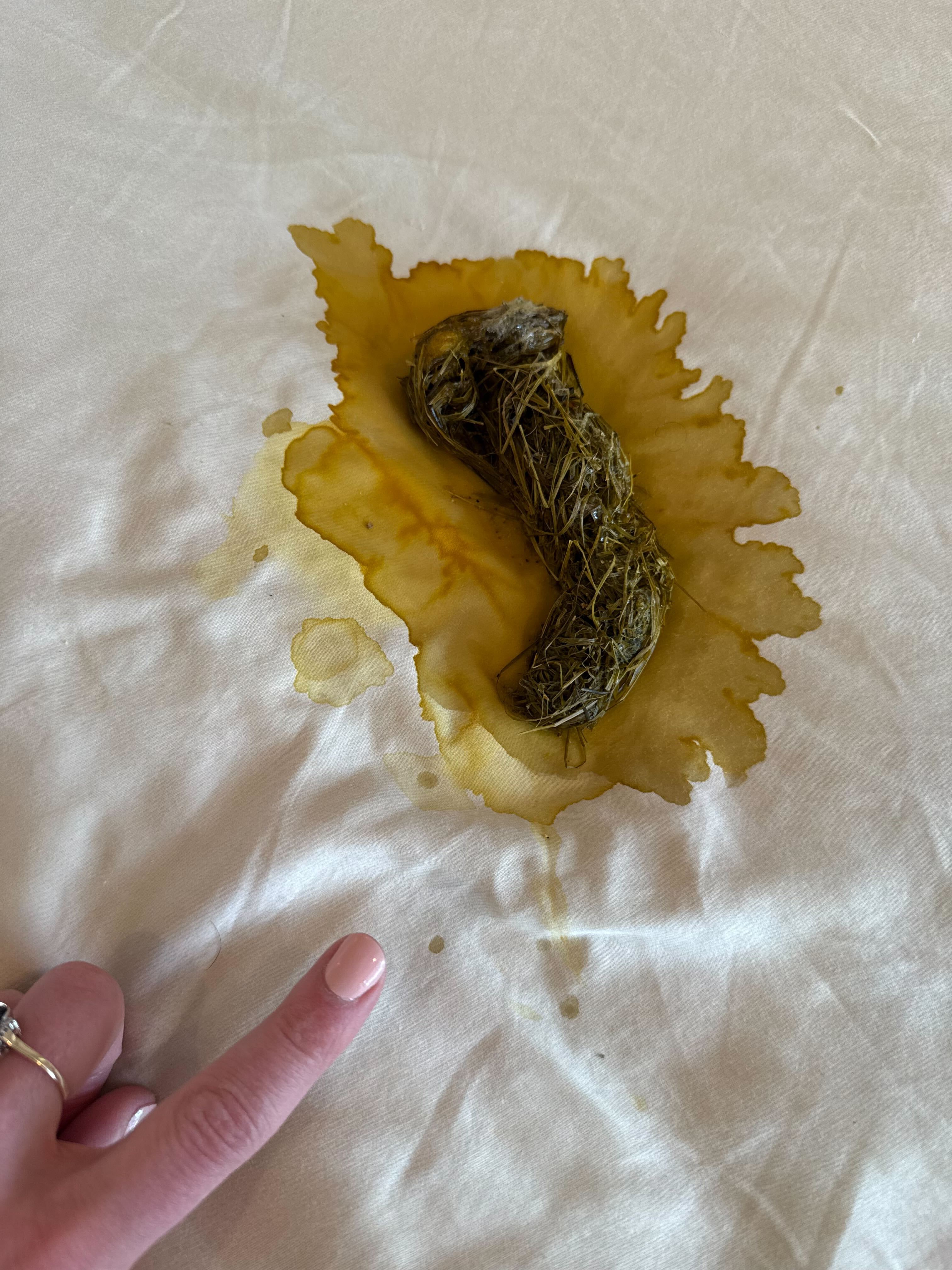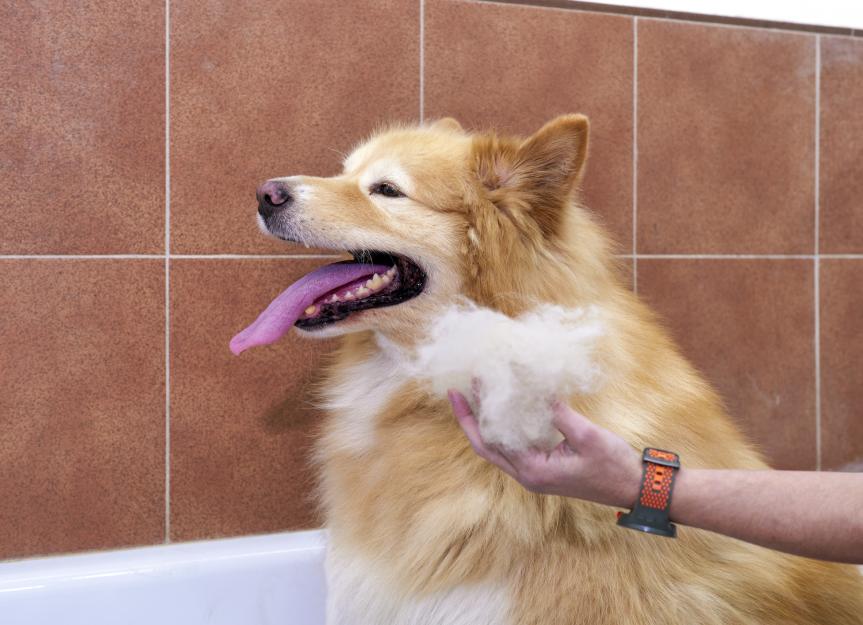When the topic of hairballs comes up, most people think of cats. However, believe it or not, dogs can get hairballs as well.
Key Takeaways
- Hairballs are called trichobezoars in dogs, with “trich” meaning hair and “bezoar” being a foreign material found in the stomach or intestines.
- Trichobezoars are most often seen in dogs with skin conditions that habitually overgroom. The overgrooming and consistent licking/chewing of their haircoat leads to swallowing too much hair.
- Dog hairballs can be a medical emergency if they are obstructive (stuck in the GI tract).
What Are Dog Hairballs?
Dog hairballs are mats of hair that collect in the stomach or intestines. When a dog gets a hairball, it can get stuck in the gastrointestinal (GI) tract if it’s not vomited up.
These hairballs are called trichobezoars in dogs, with “trich” meaning hair and “bezoar” being a foreign material found in the stomach or intestines. The large mound of hair is unable to easily move through the GI tract and is either vomited up or becomes stuck.

Any dog that licks and grooms themselves or other dogs is at risk for developing a trichobezoar. Trichobezoars can be a medical emergency if they are obstructive (stuck in the GI tract).
If your dog has vomited up a hairball, it is less concerning if they are eating, have no further vomiting, and are otherwise acting normal.
If the trichobezoar becomes obstructive, it is considered a medical emergency as dogs can have less blood flow to the GI tract as well as increased risk of aspiration (breathing in stomach contents) from chronic vomiting.
Causes of Dog Hairballs
Trichobezoars are most often seen in dogs with skin conditions that habitually overgroom. The overgrooming and consistent licking/chewing of their haircoat leads to swallowing too much hair. Hair is made up of a protein called keratin that is non-digestible.
While small amounts of swallowed hair will pass through the stool, consuming large amounts of hair or getting hair tangled around other objects (like plant matter or animal hide) can lead to trichobezoars forming.
Dogs with medium or long haircoats may be at more risk of trichobezoars if they are overgrooming since longer hair can mat together more easily.
Additionally, dogs that eat whole animals or carcasses can be at risk of trichobezoars as larger pieces of haired hide may not move through the GI tract well.
For this reason, keep your pup on a leash or under direct supervision to avoid letting them eat things they’re not supposed to.
How Veterinarians Diagnose Dog Hairballs
Trichobezoars in dogs are usually diagnosed either by a pet parent showing a veterinarian what their dog vomited up or by a diagnostic workup if they’re showing signs of gastrointestinal obstruction.
If your dog has been having chronic, intermittent vomiting, your veterinarian will likely want to do some tests. Radiographs (X-rays) will be taken to look for any unusual gas patterns.
Blood work will likely be run to figure out if the vomiting is related to any underlying organ problems.
In the case of chronic vomiting, your dog’s veterinarian may recommend several tests including a fecal float to rule out underlying parasites, a barium study to watch the flow of material through the GI tract, and even advanced imaging, like ultrasonography, to look for any underlying conditions.
Some vets may recommend food trials with hypoallergenic or high-fiber diets.
Trichobezoars in the stomach can be tricky to diagnose as hair doesn’t easily show up on X-rays. Ultimately, an abdominal exploratory surgery may be recommended if your veterinarian suspects a foreign item in the GI tract.
Let your veterinarian know if your dog is chronically licking and chewing on their haircoat. Additionally, let them know if your dog has vomited up hair in the past.
Your veterinarian will ask about when your dog last had a bowel movement and about their appetite. Let them know if your dog is eating with less enthusiasm or not having regular bowel movements. If your dog is chronically vomiting, it’s helpful for you to track how often this occurs, what they vomit, and how soon before/after meals you are seeing these episodes.
Treatment of Dog Hairballs
Dog hairballs are treated differently depending on whether they are obstructive (stuck).
If the trichobezoar is small and easily vomited up, treatment is geared toward reducing occurrence. Any underlying skin conditions are managed so that your pet is no longer overgrooming and licking as much of their fur.
Sometimes this is done with allergy medications, like Apoquel or Cytopoint.
If your dog is overgrooming because of anxiety, your veterinarian may prescribe an anxiolytic, like fluoxetine.
If the hairball is stuck in the stomach or intestines and too large to move up or down, surgery is usually recommended. Following surgery, a bland diet may be recommended—like Hill’s i/d or Royal Canin Gastrointestinal—while your dog’s GI tract is healing.
Sometimes probiotics, like FortiFlora, are recommended.
Occasionally, your veterinarian may recommend an oral laxative, like Laxatone, to help keep your dog regular.
Recovery and Management of Dog Hairballs
Recovery from trichobezoars in dogs depends on how large the hairball was.
If it was large enough to need surgery, recovery is usually about 10–14 days. Keep your pet’s activity level very low during this time and keep a dog recovery collar (such as this cone by Dogswell) on at all times that they are not under direct supervision.
Management for dogs with chronic skin conditions that have more frequent hairballs that they successfully vomit may be more long term. Soft recovery cones (such as the Kong Cloud Collar) or rubber basket muzzles may be needed to prevent overgrooming while waiting for allergy medicines to kick in.
Prevention of Dog Hairballs
To prevent dog hairballs, avoid letting your pup lick/chew at their haircoat too much. Keep them from overgrooming other dogs or cats in the household as well.
Prevent access to carcasses, bathroom trash, or other sources of hair and hide.
Dog Hairballs FAQs
How do you treat hairballs in dogs?
Hairballs are treated either surgically or medically depending on if they’re stuck or a chronic condition.
How can you tell if a dog has a hairball?
A dog with a hairball may vomit it up, or they can have more non-specific signs, like chronic vomiting without hair.
Does pumpkin help with hairballs in dogs?
No. Hairballs are not related to a lack of fiber in the diet, so pumpkin is not helpful.
Why does my dog sound like she’s trying to cough up a hairball?
A hacking cough is usually a sign of cardiopulmonary (heart and lung) disease rather than hairballs in dogs. It can be anything from kennel cough to heart disease, and all coughs should be checked by your dog’s veterinarian.
What are home remedies for dog hairballs?
Canned food can be helpful in binding up stray hair if the amount of hair your dog swallowed is small enough to easily pass in the stool.
What does a dog hairball look like?
A dog hairball looks like a cat hairball when it’s small, in that it is long and tubular with bits of hair sticking out. Larger hairballs, or trichobezoars, are like huge balls of densely packed hair that get stuck and cannot move forward through the intestines or back up through the esophagus.



